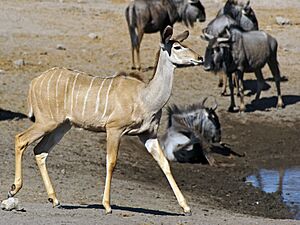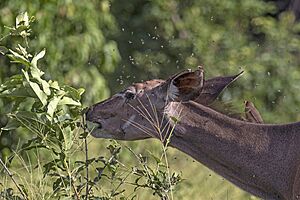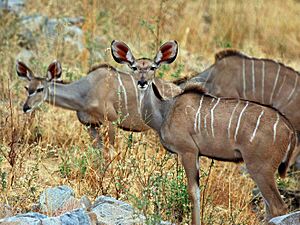Greater kudu facts for kids
Quick facts for kids Greater kudu |
|
|---|---|
 |
|
| Adult male | |
 |
|
| Adult female | |
| Conservation status | |
| Scientific classification | |
| Subspecies | |
|
|
 |
|
| Ranges of the subspecies
T. s. cottoni T. s. chora T. s. strepsiceros |
|
| Synonyms | |
|
Strepsiceros chora |
The greater kudu (Tragelaphus strepsiceros) is a very large antelope that lives in woodlands. You can find them across eastern and southern Africa. Even though they live in many places, there are not many of them in most areas. This is because their habitat (their natural home) is shrinking. Things like deforestation (cutting down forests) and poaching (illegal hunting) are big problems for them. The greater kudu is one of two types of kudu. The other one is the lesser kudu, which is smaller.
Contents
What's in a Name?
The name "Kudu" comes from the Khoikhoi people. They are a group of people from southern Africa. The scientific name, Tragelaphus strepsiceros, also has a meaning.
- Trag- comes from a Greek word for goat.
- Elaphos is a Greek word for deer.
- Strepho means 'twist' in Greek.
- Keras means 'horn'.
So, the name describes a goat-like deer with twisted horns!
Physical Features of the Greater Kudu
Greater kudus have a thin body and long legs. Their fur can be brown, bluish-grey, or reddish-brown. They usually have between 4 and 12 thin white stripes down their sides. Their head is often darker than the rest of their body. They also have a small white mark shaped like a 'V' between their eyes.
Males vs. Females
Male greater kudus, called bulls, are much bigger than females, called cows. Bulls also make more sounds. They make low grunts, clucks, and humming noises. Male kudus have a beard of hair along their throats. They also have amazing, large horns that twist two and a half times. If these horns were straightened, they would be about 120 cm (47 inches) long. The longest recorded horn was 187.64 cm (73.87 inches)! These horns grow outwards and slightly backwards from their head.
Kudu horns start growing when a bull is about 6 to 12 months old. The first twist forms around 2 years of age. They don't get the full two and a half twists until they are about 6 years old. Sometimes, they can even have three full turns!
Size and Appearance
The greater kudu is one of the biggest antelopes. It's only a little smaller than a bongo.
- Male bulls weigh between 190 and 270 kg (419-595 lb). Some can weigh up to 315 kg (694 lb). They stand up to 160 cm (63 inches) tall at the shoulder.
- Female cows weigh between 120 and 210 kg (265-463 lb). They can be as short as 100 cm (39 inches) tall at the shoulder. Cows do not have horns, beards, or the nose markings.
Both males and females have large, round ears. Their body length is about 185 to 245 cm (6 to 8 ft). Their tail can add another 30 to 55 cm (12 to 22 inches) to their length.
Where Greater Kudus Live
Greater kudus live in many parts of Africa. You can find them in:
- East Africa: Ethiopia, Tanzania, Eritrea, and Kenya.
- Southern Africa: Zambia, Angola, Namibia, Botswana, Zimbabwe, and South Africa.
They also live in the Central African Republic, Chad, Democratic Republic of the Congo, Djibouti, Eswatini, Malawi, Mozambique, Somalia, and Uganda.
Their Home and Food
Kudus prefer to live in woodlands with mixed bushes and trees. They like areas with mopane bush and acacia trees. They might go into open plains if there are lots of bushes, but they usually avoid wide-open spaces. This helps them hide from predators.
Their diet includes:
- Leaves
- Grass
- Shoots (new plant growth)
- Sometimes tubers (like potatoes), roots, and fruit. They especially love oranges and tangerines!
During hot days, greater kudus usually rest under trees. They eat and drink in the early morning and late afternoon. They get water from waterholes or from roots and bulbs that hold a lot of water. Even though they usually stay in one area, they can travel long distances to find water during dry times.
Who Hunts the Kudu?
The main predators of the greater kudu are lions, spotted hyenas, and African wild dogs. Cheetahs and leopards also hunt kudus, but they usually go for the smaller cows and calves, not the big bulls. Sometimes, Nile crocodiles might also hunt kudus, but bigger land predators are more dangerous to them.
When a group of kudus feels threatened, an adult (usually a female) will make a loud bark. This warns the rest of the group. Kudus are very good at moving quickly over rocky hills and mountains. However, they are not fast enough to escape their main predators in open areas. So, they try to escape by leaping over bushes and small trees.
Greater kudus have excellent hearing and sharp eyesight. These senses help them spot predators coming. Their fur color and markings also help them blend in with their surroundings. If they are scared, they often stand very still, which makes them hard to see.
Kudu Behavior and Social Life
Greater kudus usually live for 7 to 8 years in the wild. In zoos, they can live up to 23 years. They can be active at any time of day or night.
Grouping and Home Ranges
When there is plenty of food during the rainy season, kudu groups spread out. But in the dry season, when food is harder to find, they gather in areas where food is available. Greater kudus do not defend a specific territory. Instead, they have "home areas."
- Female groups with their young usually have home areas of about 4 square kilometers (1.5 square miles). These areas can overlap with other female groups.
- Adult males have larger home areas, about 11 square kilometers (4.2 square miles). These areas usually cover the ranges of two or three female groups.
Females often form small groups of 6 to 10 individuals with their offspring. Sometimes, these groups can grow to up to 20 kudus. Male kudus might form small groups of bachelors, but they are more often found alone. Solitary males only join female and calf groups during the mating season, which is usually in April or May in South Africa.
Male Interactions
Male kudus don't always fight each other. But sometimes, they will spar, especially if they are similar in size. When sparring, they lock their horns together and push each other. One male shows dominance by displaying his side to the other. In very rare cases, males can get their horns stuck together. This can lead to both animals dying.
It's rare for a kudu herd to have 40 individuals. This is partly because they are picky eaters. Finding enough food for a very large group would be hard. A herd's home area can be about 800 to 1500 acres. They spend about 54% of their day looking for food.
Reproduction and Life Cycle
Greater kudus become ready to have babies between 1 and 3 years of age. The mating season happens at the end of the rainy season. The exact time can change a little depending on the area and weather.
Mating and Birth
Before mating, the male and female have a special dance. The male stands in front of the female and sometimes they "wrestle" with their necks. Then, the male follows the female, making a low sound until she lets him mate with her.
Being pregnant (gestation) lasts about 240 days, or eight months. Calving (giving birth) usually happens between February and March. This is when the grass is usually tallest.
Greater kudus usually have one calf, but sometimes they have two. The pregnant female leaves her group to give birth. After the calf is born, she hides it in plants for about 4 to 5 weeks. This helps keep the newborn safe from predators. After this time, the calf will go with its mother for short periods. By 3 to 4 months old, it will stay with her all the time. By 6 months old, the calf is quite independent. Most births happen during the wet season (January to March). Female kudus are ready to have babies at 15 to 21 months old. Males are ready at 21 to 24 months old.
Greater Kudus and Humans
Humans have both helped and harmed greater kudus.
- Challenges: People are turning much of the kudu's natural home into farms. This shrinks the areas where kudus can live. Humans have also cut down the woodlands that kudus use for shelter. Poachers also hunt kudus illegally for their meat and horns.
- Benefits: However, wells and irrigation systems built by humans have also allowed kudus to live in areas that were too dry for them before.
The horns of greater kudus are sometimes used to make Shofars. These are special horns blown during Jewish religious ceremonies like Rosh Hashanah. The greater kudu also appears on the 50-cent coin of Eritrea.
Conservation Status
The number of greater kudus in the northern part of their range has gone down. This is due to too much hunting and fast loss of their habitat. However, overall, the greater kudu is listed as "Least Concern" on the IUCN Red List of endangered species. This means their long-term survival is not currently in danger. This is because populations in other areas are strong and well-managed.
Greater kudus are well protected in areas from southern Tanzania to South Africa. There are large populations in many national parks and reserves, such as:
- Ruaha-Rungwa-Kisigo and Selous (Tanzania)
- Luangwa Valley and Kafue (Zambia)
- Etosha (Namibia)
- Moremi, Chobe and Central Kalahari (Botswana)
- Hwange, Chizarira, Mana Pools and Gonarezhou (Zimbabwe)
- Kruger (with 11,200–17,300 individuals) and Hluhluwe–iMfolozi (South Africa)
Many greater kudus also live on private farms and wildlife areas in southern Africa. They are popular for trophy hunting there.
Images for kids
-
Male calf
Tswalu Kalahari Reserve, South Africa -
Juvenile male
Chobe National Park, Botswana -
Taxidermied specimens at the American Museum of Natural History.
See also
- Lesser kudu
- Kudu dung spitting











